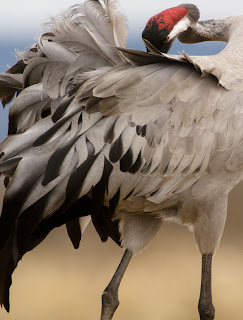It features a gray body, brown on the back, face and throat black, and long legs, thick and dark. It reaches three feet in length and a wingspan that can reach two meters. In flight, the wing has straight, flat and very characteristic long neck. During the courtship, their behavior makes them very visible and you can see perfectly the lack of sexual dimorphism between male and female. In flight, often grouped in large groups with v-shaped.
His voice is strong, resonant, very striking during the breeding season.
His voice is strong, resonant, very striking during the breeding season.
Se caracteriza por su cuerpo gris, pardo en el dorso; cara y garganta negras; y largas patas gruesas y oscuras. Alcanza de un metro de longitud y una envergadura alar que puede alcanzar los dos metros. En vuelo, posee las alas rectas, planas y un cuello largo muy característico. Durante la época de cortejo, su comportamiento las hace muy visibles y se puede apreciar perfectamente la falta de dimorfismo sexual entre el macho y la hembra. En vuelo, suele agruparse en grandes grupos con forma de uve.
Su voz es fuerte, resonante, muy llamativa durante la época de cría.
Su voz es fuerte, resonante, muy llamativa durante la época de cría.
After a collective ritual ceremonies and very attractive, couples choose a quiet place preferably between marsh plants near the pond where the female prepares a nest with a large pile of stems and leaves. It lays two eggs placed in a single nest from May to July and whose incubation is prolonged for a month. The first chick is left to the father and the second usually born 2 days after that of the mother. The chicks have a very fast and usually are able to fly within two months.
Después de unas ceremonias rituales colectivas y muy vistosas, las parejas escogen un sitio tranquilo preferentemente entre plantas palustres próximas a la orilla del estanque donde la hembra prepara un nido con un montón grande de tallos y hojas. La puesta es de dos huevos situados en una única nidada, de mayo a julio y cuya incubación se prolonga durante un mes. El primer polluelo queda a cargo del padre y el segundo normalmente nacido 2 días después al de la madre. Los polluelos tienen un desarrollo muy rápido y generalmente son capaces de volar a los dos meses.
It is distributed throughout Europe. It breeds in the north, in bogs or marshes, and migrates to coastal areas. In winter, next to muddy lakes in southwestern Europe, as the Gallocanta Lake (Gallocanta, Spain). A large number of cranes continue their migration to the National Parks of Castilla-La Mancha of Las Tablas de Daimiel and Cabañeros, the pastures of Extremadura and south to La Janda in Cadiz and even in Morocco, where one of the wintering populations further south is the mouth of the river Massa. No known subspecies
Se distribuye por toda Europa. Cría en el norte, en cenagales o en marjales, y migra a zonas costeras. En invierno, se encuentra junto a lagos fangosos, en el suroeste europeo, como la laguna de Gallocanta, (Gallocanta, España). Un gran número de grullas continúan su migración hacia los Parques Nacionales de Castilla-La Mancha de Las Tablas de Daimiel y Cabañeros, las dehesas extremeñas y más hacia el sur, hasta La Janda en Cádiz y aún en Marruecos, donde una de las poblaciones invernantes más meridionales se encuentra en la desembocadura del río Massa. No se conocen subespecies




No hay comentarios:
Publicar un comentario